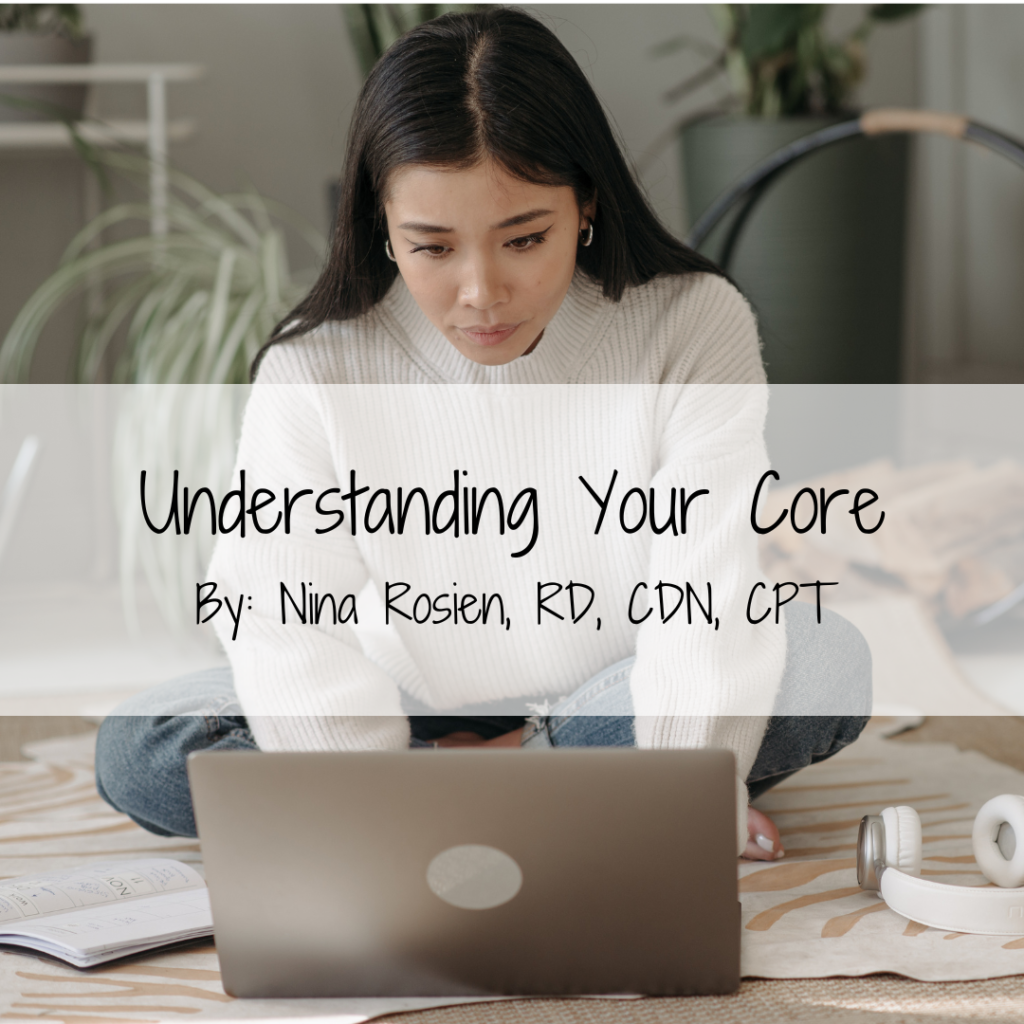
On my journey to becoming a certified personal trainer, one of the components of the learning process that fascinated me was the importance of core strength and stability. Whether it was learning to do a basic squat, standing in a static position, or going for a run – the support comes down to the stability, strength, and endurance of your core. Appropriately strengthening and building endurance in your core is one of the most influential elements of any training program.
More commonly when thinking of our core, the dialogue becomes overshadowed with the idea of “getting abs” – which may sound a little more familiar. However the priority should be focused on what your body can do and how it feels, versus how it looks or is seen by others. With a stable and strong core, you are likely to feel more comfortable in your everyday body movements. There are little tricks and habits you can add in or incorporate in your day that can work towards benefiting your core.
Now, you may be wondering- why a Registered Dietitian is preaching about core strength on a nutrition website? It’s because your core strength can actually impact your digestion! The muscles of the core actually compress our intestinal contents which increases intra-abdominal pressure and assists in expulsion of fecal material (aka it makes it easier to poop). Additionally, core strengthening exercises have been shown to reduce colonic transit time (the time it takes for food to move through your large intestine) making core exercises an excellent addition to constipation prevention. Finally, there is some research that suggests a variety of regular exercise (including core training) may increase gut microbial diversity and promote the growth of symbiotic bacteria populations. This leads to a healthier status and possibly, also enhancing physical performance.
- note: There are many additional variables that can impact gut health such as hydration, fiber intake, meal hygiene, and more. Check with your Registered Dietitian at Pearls of Nutrition for further support.
Here are some additional benefits of strengthening your core:
Benefits of strengthening your core:
- Everyday tasks may become more comfortable or easier– Day to day actions include your core. Whether it’s driving your car to work, getting dressed in the morning, or taking your dog on a walk, your core is an essential component of all these movements.
- Improvements in lower back pain – Almost 80% of adults experience some form of low-back pain in their lifetime. An unstable core limits the ability of our limbs to movement, and causes us to heavily rely on other parts of the body leading to potential back or hip pain. Core training can improve trunk and low-back posture, as well as body awareness.
- Improved performance in sports and physical activity – Per the National Academy of Sports Medicine (NASM), a strong and stable core is important for generating strong and explosive movements needed for optimal physical performance.
- Better Posture – Proper core muscle function is essential for maintaining natural spinal curvatures, which can be increased or decreased as a result of improper core muscle balance. Appropriate posture throughout the spine is important for ensuring proper extremity movements, and enhancing the performance of the entire neuromuscular system.
- Balance, Stability, Prevention of Falling – A meta analysis concluded that core strength training was an important factor in fall prevention, especially in older adults.
- Increasing resistance to injury – As said previously, muscle function is crucial for proper extremity movements. Because of this, optimal core muscle function has been considered a factor that may modify injury risk. A prospective cohort study demonstrated that lower postural control, hip muscle strength, and core muscle endurance were predictive of individuals who developed injuries over a 1.5-year period.
So what IS your core? Surprisingly, your core is more than just your abdominal muscles. The core, also known as the lumbo-pelvic-hip complex (LPHC), includes a variety of parts of the body such as:
- Lumbar spine (low-back area)
- Pelvis
- Abdomen
- Hip musculoskeletal structures
The LPHC is a structure of the body that connects our upper and lower halves. When we are able to increase strength and stability of the LPHC, it also increases improvements in performance and prevention of injuries. Developing ways of training your core or incorporating better posture in day to day movement becomes essential.
To put it simply, the core region/LPHC is at the body’s center of gravity and includes (but is not limited to) the abdominals, hips, gluteal complex, and low-back area. The core musculature can be divided into two unique categories:
- Local muscles: These muscles primarily attach on or near the vertebrae and often have short attachments ranging between one and two vertebrae segments. Local muscles provide dynamic control of the spinal segments that limit excessive compression and rotational forces between spinal segments. This quality is important for stabilizing the vertebrae and limiting strain on passive stabilizing structures, including intervertebral discs and ligaments.
- Global Muscles: Global core muscles are positioned more superficially on the trunk when compared to local core muscles. The global muscles of the core act to move the trunk, transfer loads between the upper and lower extremities, and provide stability of the spine by stabilizing multiple segments together as functional units.
To maintain optimal stability and function of the core, it is important to systematically condition ALL muscles of the core. Together, the local and global muscles work to stabilize the spine while producing efficient arm and leg movements. These muscles work together to produce strong, effective movements of the trunk while continuing to stabilize the spine. The local muscles have to function correctly for an individual to effectively use the strength, power, and endurance that has been developed in the prime movers, such as your arms and legs. If the global muscles are strong and the local muscles are weak, forces along your entire body might not be transferred or used effectively. Both the global muscles and local muscles in isolation do not achieve proper stabilization of the core. Instead, the cooperation of both local and global muscles work together to enhance stability of the core. In other words, training the global muscles before training the local muscles would not be ideal. Similar to building a house without a foundation, the foundation of one must be developed first to provide a stable platform for the remaining components of the house to be built on. One must first be stable to move cohesively and efficiently. Weakness of the global and local core musculature is a fundamental problem that causes inefficient movement and can lead to poor posture, decreased athletic performance, increased risk of injury, and inability to adequately return to activity following a previous injury. For this reason, properly training local and global core musculature is extremely impactful for maintaining proper posture and improving performance, as well as increasing injury resilience and enhancing injury rehabilitation.
According to the National Academy for Sports Medicine (NASM), research has shown that activation of global and local musculature, when contracted together, create the best benefit for those with low back pain compared with traditional low back pain training methods, such as solely emphasizing range of motion at the spine. Now knowing the importance of activating both local and global muscles, what are some ways to practice this?
- Drawing in maneuver- A maneuver used to recruit the local core stabilizers by drawing in the navel toward the spine. To perform the drawing-in maneuver, pull in the region just below the navel toward the spine and maintain the cervical spine in a neutral position.
- Bracing – Imagine yourself being a goalie in a soccer game, and a ball is kicked right to your abdomen. At that moment your core is bracing itself for impact. Bracing is referred to as a co-contraction of global muscles, such as the external obliques. It’s also commonly referred to as a “bearing down” or tightening of the global muscles by consciously contracting them.
While these maneuvers seem complex, you can practice them when you’re walking or even sitting at work! In times that you find yourself slouching, try rounding out your shoulders and drawing in your navel towards your spine. Remember to continue breathing during this process, and avoid holding your breath.
The intention of core training is the evolution of core stability, endurance, strength, and power. Core stability and core endurance refer to the ability of an individual to maintain spinal and hip posture while the extremities (i.e., arms and legs) are moving. An example of this is having a neutral spine when attempting to do a squat. Core strength refers to the ability to contract the torso in all directions (i.e., flexion, extension, rotation) such as a standard floor crunch, and core power involves explosive movements of the core musculature which can include a medicine ball soccer throw.
Two simple tips you can incorporate everyday to activate your core:
- “Sit up Straight!” – This may sound familiar, but it is very common for people with posture issues to have a tendency to slouch their shoulders when sitting or standing. Sometimes when we notice this, we tend to “overcorrect” by arching our back and causing increased extension in our lumbar extensors (lower back muscles). Doing this repeatedly can cause muscle imbalances and decreased pelvic stabilization. Instead try keeping your core engaged, using some of the strategies above, to create a neutral spine. You can practice this on long car rides as well!
- Incorporate Movement- Sometimes with desk jobs, or jobs where you’re sitting and driving in a car all day, we forget to get up and take breaks. Doing this for so long causes us to ignore our core and put it in “relaxation mode” where we aren’t keeping it activated. Try setting a timer, or putting it on your work calendar to stop and get up every 30-40 minutes or stop for bathroom breaks. Make it a point to get some water, take a trip outside for some fresh air, or walk up and down the halls of the office or your house. When doing so, be mindful of what your core is doing!
Ready to start exercising your core? Here are some beginner core exercise stabilization examples:
- Floor bridge – How to do a Floor Bridge – YouTube
- Plank – How to do a Plank – YouTube
- Dead bug – How to do a Dead Bug | Proper Form & Technique | NASM – YouTube
- Bird dog – How to do a Bird Dog | Proper Form & Technique | NASM – YouTube
- Side plank – https://www.youtube.com/watch?v=44ND4bOB-T0
- Floor cobra- How to do a Floor Prone Cobra – YouTube
If you are unable to do exercises while lying down for any reason, here are some examples of core exercises that can be done while sitting: Seated Abs Workout: Chair Exercises for Your Core – YouTube
*PLEASE NOTE: It is best to work with your certified personal trainer on proper progression of a core training program. The examples above are basic recommendations meant for educational purposes only. Please be sure to check with your doctor before beginning any physical activity.
It is also important to check in with your Registered Dietitian prior to starting additional exercise, especially for those in eating disorder recovery. We want to make sure exercise is safe for your place in recovery and you are fueling your body adequately to fuel any additional movements.
Resources:
Bycura D, Santos AC, Shiffer A, Kyman S, Winfree K, Sutliffe J, Pearson T, Sonderegger D, Cope E, Caporaso JG. Impact of Different Exercise Modalities on the Human Gut Microbiome. Sports (Basel). 2021 Jan 21;9(2):14. doi: 10.3390/sports9020014. PMID: 33494210; PMCID: PMC7909775.
Granacher U, Gollhofer A, Hortobágyi T, Kressig RW, Muehlbauer T. The importance of trunk muscle strength for balance, functional performance, and fall prevention in seniors: a systematic review. Sports Med. 2013 Jul;43(7):627-41. doi: 10.1007/s40279-013-0041-1. PMID: 23568373.
De Blaiser C, De Ridder R, Willems T, Vanden Bossche L, Danneels L, Roosen P. Impaired Core Stability as a Risk Factor for the Development of Lower Extremity Overuse Injuries: A Prospective Cohort Study. Am J Sports Med. 2019 Jun;47(7):1713-1721. doi: 10.1177/0363546519837724. Epub 2019 Apr 29. PMID: 31034240.
Cella V, Bimonte VM, Sabato C, Paoli A, Baldari C, Campanella M, Lenzi A, Ferretti E, Migliaccio S. Nutrition and Physical Activity-Induced Changes in Gut Microbiota: Possible Implications for Human Health and Athletic Performance. Foods. 2021 Dec 10;10(12):3075. doi: 10.3390/foods10123075. PMID: 34945630; PMCID: PMC8700881.
Majority of content from:
NASM Certified Personal Trainer, 7th Edition


